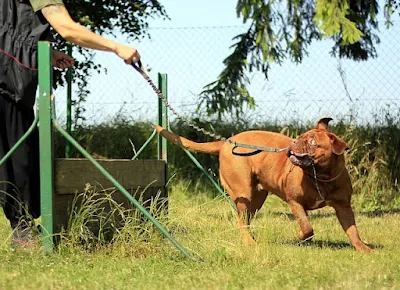How to Train a Big Dog
Summary: Training a big dog is very important. When your 120-pound dog jumps on your 90-year-old Great Aunt Gilbert it can cause big problems. A big dog also has a different set of problems than someone who has an 8-pound teacup poodle. A big dog can injure you when out for a walk, they can destroy thousands of dollars worth of household goods and more. In this article you'll discover some important steps to follow to get your big dog under control and listening to your commands.
How to Train a Big Dog
Step1
The first step to training your big dog has nothing to do with training. The first step is to make sure your big dog gets enough exercise. About 80 percent of the big dogs that I help train have so much pent-up energy that they can't focus and have a hard time doing obedience. When your dog has enough exercise it is much easier for your dog to live with you and it is much easier for you to live with your dog. When your big dog has had enough exercise it will be easier to train and many behavior problems will go away. A good quote to remember is: "The only good dog is a tired dog."
Step2
Once your big dog is getting enough exercise you need to establish leadership. Leadership is extremely important. The most important part of having a big dog is making sure that he never becomes aggressive. Dogs resolve conflict by using aggression. There can't be any conflict when you ask your dog to get off the couch, to drop a chicken bone that you may have dropped, to allow you to check his ears and paws .
Step3
Crate train your big dog. At some point in your dog's life they will have to go to a groomer, a vet or travel. This will require your dog to go into a crate. Crate training can be done by associating the crate in a positive way. Tossing in your dog's toys and treats and putting the food bowl in the back of the crate are all things that you can do to get your dog to like the crate. If your dog has a chewing or housetraining problem a crate can help you with these problems. A big dog can do thousands of dollars in damage in a very short period of time. Your dog can also get injured if left unattended; a crate is a safe place for your dog to be when you are not around .
Step4
Having a back tie in your house can also help when company comes over or you are too busy to keep an eye on your dog. A back tie is a simple leash secured to a very solid wall. A typical back tie would be an eye hook screwed into a very sturdy wall with a leash attached to it. When company comes over and you have your dog secured to the back tie your guests can come in and not worry about getting knocked over. Most big dogs get very excited when company comes over and jump on them. Your guests or you push the dog off which tends to get the dog even more excited. With your dog on the back tie everyone can simply ignore your dog until he calms down. Most dogs calm down after a few minutes. Once your dog is calm and not jumping you and your guests can give your dog attention for not jumping.
Step5
The big mistake some trainers make is thinking that a big dog needs to be trained with harsh, physical methods. One of the reasons dogs are so aggressive in the United States is from the training methods used. Constantly inflicting pain on a dog by using a choke, prong or electronic collar will take its toll on the dog. I have seen puppies as young as three months old with prong collars on. I have seen trainers teach "alpha rollovers," smacking the dog for normal canine behavior, hanging the dog on a choke collar and other training techniques that are extremely harsh. There is only so much punishment any living animal can take before they snap, and that is exactly what is happening with dogs today. Punishment can be a very effective way to change behavior, but overdone it leads to aggression. The best way to train your big dog is to use positive methods. Train your dog by reinforcing behaviors. The last thing you want is a big dog that becomes aggressive. Some important commands to teach are sit, down, stand, stay, walk on leash and come.

